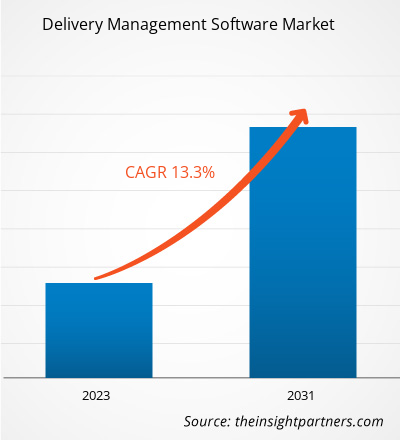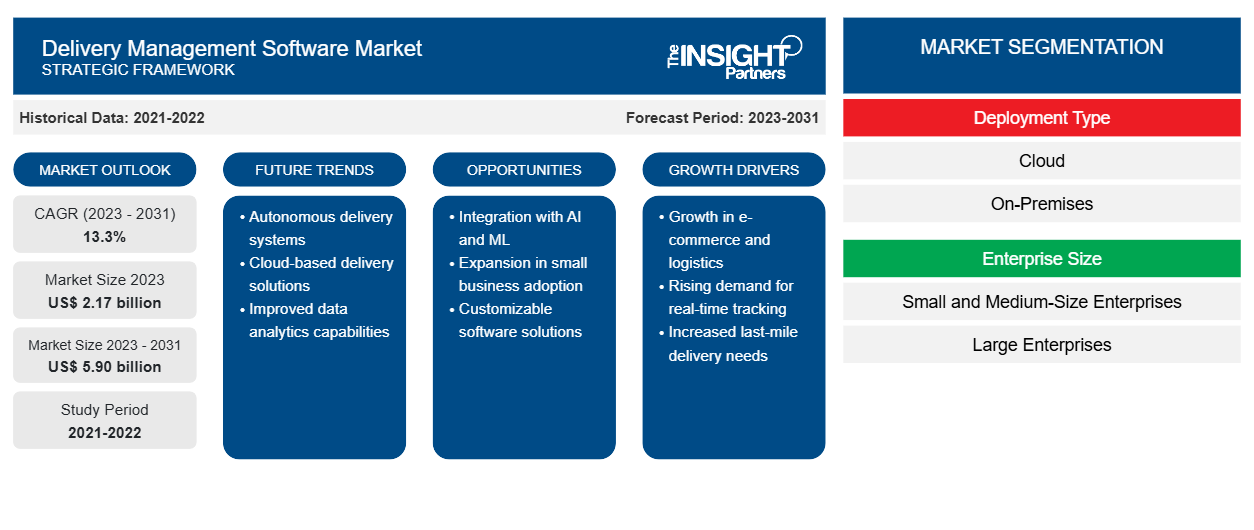Se proyecta que el tamaño del mercado de software de gestión de entregas alcance los 5.900 millones de dólares estadounidenses para 2031, desde los 2.170 millones de dólares estadounidenses en 2023. Se espera que el mercado registre una CAGR del 13,3 % entre 2023 y 2031.
Es probable que la integración de tecnologías de inteligencia artificial y aprendizaje automático en el software de gestión de entregas para mejorar la experiencia del consumidor siga siendo una tendencia clave del mercado del software de gestión de entregas.
Análisis del mercado de software de gestión de entregas
El mercado de software de gestión de entregas está creciendo a un ritmo rápido debido a la expansión de la industria del comercio electrónico y la creciente demanda de información en tiempo real para gestionar la logística y las cadenas de suministro. El mercado se está expandiendo de manera constante, impulsado por el crecimiento de la población, la creciente digitalización y la preferencia de los consumidores por las compras en línea. Además, la creciente demanda de automatización por parte de los usuarios finales está brindando oportunidades lucrativas para el crecimiento del mercado.
Descripción general del mercado de software de gestión de entregas
El software de gestión de entregas se utiliza para realizar un seguimiento de los envíos y garantizar la entrega puntual de los artículos a los clientes. El uso de un software de gestión de entregas innovador proporciona importantes beneficios a las empresas, como el aumento de la utilización de los activos, la mejora de la satisfacción del cliente y la reducción del consumo de combustible. El software conecta al conductor de la entrega y a las oficinas administrativas en una única plataforma y proporciona la información que necesita el conductor para entregar un artículo. La creciente demanda de información en tiempo real y un mejor seguimiento de las entregas está impulsando el mercado.
Personalice este informe según sus necesidades
Obtendrá personalización en cualquier informe, sin cargo, incluidas partes de este informe o análisis a nivel de país, paquete de datos de Excel, así como también grandes ofertas y descuentos para empresas emergentes y universidades.
- Obtenga las principales tendencias clave del mercado de este informe.Esta muestra GRATUITA incluirá análisis de datos, desde tendencias del mercado hasta estimaciones y pronósticos.
Factores impulsores y oportunidades del mercado del software de gestión de entregas
La expansión de la industria del comercio electrónico está impulsando el mercado
La creciente industria del comercio electrónico y la creciente demanda de servicios de entrega de última milla entre los consumidores están impulsando el mercado. El negocio del comercio electrónico se está expandiendo rápidamente en todo el mundo, ya que cada vez más consumidores prefieren las compras en línea como una opción conveniente. Esto da como resultado una creciente demanda de servicios de entrega entre los consumidores, particularmente la entrega de última milla. La entrega de última milla es una parte crucial del negocio del comercio electrónico. Implica el transporte de productos básicos desde el almacén hasta la puerta del cliente. Las empresas de comercio electrónico se centran en garantizar que sus artículos lleguen a los clientes de forma rápida y rentable, lo que aumenta la demanda de software de gestión de entregas entre las empresas. Sin embargo, la expansión de la industria del comercio electrónico y el cambio de la preferencia de los consumidores hacia las compras en línea están impulsando el mercado.
Demanda creciente de automatización por parte de los usuarios finales: una oportunidad en el mercado del software de gestión de entregas
La aparición de tecnologías de vanguardia presenta un potencial de crecimiento rentable para el mercado de software de gestión de entregas. Los grandes actores del mercado de software de gestión de entregas están realizando inversiones significativas en la adopción de tecnologías de IA y ML para automatizar sus procesos de entrega. Además, la automatización está ganando terreno en la gestión de entregas al ayudar a las empresas a mejorar sus procedimientos de cumplimiento de pedidos y entrega. La automatización ayuda a los usuarios finales, como la entrega de restaurantes, la logística, las empresas de mensajería y otros, a agilizar los procedimientos, reducir los costos y mejorar la experiencia del cliente. Numerosas tecnologías de automatización, como la optimización de rutas, los portales de autoservicio y la entrega automatizada, son ampliamente adoptadas por las empresas de logística para una entrega de productos más rápida y efectiva.
Análisis de segmentación del informe de mercado de software de gestión de entregas
Los segmentos clave que contribuyeron a la derivación del análisis del mercado del software de gestión de entregas son el tipo de implementación, el tamaño de la empresa y el usuario final.
- Según el tipo de implementación, el mercado de software de gestión de entregas se divide en nube y local. El segmento de la nube tuvo una mayor participación de mercado en 2023.
- En términos de tamaño de empresa, el mercado de software de gestión de entregas se divide en pequeñas y medianas empresas y grandes empresas. El segmento de grandes empresas tuvo una mayor participación de mercado en 2023.
- En función del usuario final, el mercado se segmenta en entrega a domicilio en restaurantes, logística, mensajería y otros. El segmento de logística tuvo la mayor participación del mercado en 2023.
Análisis de la cuota de mercado del software de gestión de entregas por geografía
El alcance geográfico del informe de mercado del software de gestión de entregas se divide principalmente en cinco regiones: América del Norte, Asia Pacífico, Europa, Medio Oriente y África, y América del Sur/América del Sur y Central.
En términos de ingresos, Asia Pacífico representó la mayor participación de mercado en software de gestión de entregas, debido a la expansión del sector del comercio electrónico, el crecimiento de la población y la preferencia de los consumidores por las compras en línea. La creciente demanda de software de gestión de entregas entre las empresas para optimizar sus procesos de entrega mediante la reducción de los costos logísticos adicionales está impulsando el mercado. Además, el avance tecnológico y la creciente demanda de software basado en la nube para gestionar adecuadamente la entrega de productos están creando oportunidades en el mercado.
Noticias y desarrollos recientes del mercado de software de gestión de entregas
El mercado de software de gestión de entregas se evalúa mediante la recopilación de datos cualitativos y cuantitativos a partir de una investigación primaria y secundaria, que incluye publicaciones corporativas importantes, datos de asociaciones y bases de datos. A continuación, se incluye una lista de los avances en el mercado de software de gestión de entregas y estrategias:
- En febrero de 2024, Inspire Brands compró "Vromo" para optimizar los canales de entrega. Vromo es un software de entrega de alimentos en línea que ayuda a Inspire Brands a operar su proceso de entrega al brindar beneficios de seguimiento de la entrega al cliente final. (Fuente: Inspire Brands, comunicado de prensa, 2024)
Perspectivas regionales del mercado de software de gestión de entregas
Los analistas de Insight Partners explicaron en detalle las tendencias y los factores regionales que influyen en el mercado de software de gestión de entregas durante el período de pronóstico. Esta sección también analiza los segmentos y la geografía del mercado de software de gestión de entregas en América del Norte, Europa, Asia Pacífico, Oriente Medio y África, y América del Sur y Central.

- Obtenga datos regionales específicos para el mercado de software de gestión de entregas
Alcance del informe de mercado de software de gestión de entregas
| Atributo del informe | Detalles |
|---|---|
| Tamaño del mercado en 2023 | 2.170 millones de dólares estadounidenses |
| Tamaño del mercado en 2031 | 5.900 millones de dólares estadounidenses |
| CAGR global (2023 - 2031) | 13,3% |
| Datos históricos | 2021-2022 |
| Período de pronóstico | 2023-2031 |
| Segmentos cubiertos | Por tipo de implementación
|
| Regiones y países cubiertos | América del norte
|
| Líderes del mercado y perfiles de empresas clave |
|
Densidad de actores del mercado de software de gestión de entregas: comprensión de su impacto en la dinámica empresarial
El mercado de software de gestión de entregas está creciendo rápidamente, impulsado por la creciente demanda de los usuarios finales debido a factores como la evolución de las preferencias de los consumidores, los avances tecnológicos y una mayor conciencia de los beneficios del producto. A medida que aumenta la demanda, las empresas amplían sus ofertas, innovan para satisfacer las necesidades de los consumidores y aprovechan las tendencias emergentes, lo que impulsa aún más el crecimiento del mercado.
La densidad de actores del mercado se refiere a la distribución de las empresas o firmas que operan dentro de un mercado o industria en particular. Indica cuántos competidores (actores del mercado) están presentes en un espacio de mercado determinado en relación con su tamaño o valor total de mercado.
Las principales empresas que operan en el mercado de software de gestión de entregas son:
- Deliforce Technologies, sociedad privada limitada
- FarEye (RoboticWares Pvt Ltd)
- GetSwift Limitada
- Obras de la jungla
- Soluciones Loginext Private Limited
- Mobisoft Infotech LLC
Descargo de responsabilidad : Las empresas enumeradas anteriormente no están clasificadas en ningún orden particular.

- Obtenga una descripción general de los principales actores clave del mercado de software de gestión de entregas
Informe de mercado sobre software de gestión de entregas: cobertura y resultados
El informe “Tamaño y pronóstico del mercado del software de gestión de entregas (2023-2031)” proporciona un análisis detallado del mercado que cubre las siguientes áreas:
- Tamaño del mercado y pronóstico a nivel global, regional y nacional para todos los segmentos clave del mercado cubiertos bajo el alcance
- Dinámica del mercado, como impulsores, restricciones y oportunidades clave
- Principales tendencias futuras
- Análisis detallado de las cinco fuerzas de Porter y PEST y FODA
- Análisis del mercado global y regional que cubre las tendencias clave del mercado, los principales actores, las regulaciones y los desarrollos recientes del mercado.
- Análisis del panorama de la industria y de la competencia que abarca la concentración del mercado, el análisis de mapas de calor, los actores destacados y los desarrollos recientes
- Perfiles detallados de empresas
- Análisis histórico (2 años), año base, pronóstico (7 años) con CAGR
- Análisis PEST y FODA
- Tamaño del mercado, valor/volumen: global, regional y nacional
- Industria y panorama competitivo
- Conjunto de datos de Excel
Informes recientes
Informes relacionados
Testimonios
Razón para comprar
- Toma de decisiones informada
- Comprensión de la dinámica del mercado
- Análisis competitivo
- Información sobre clientes
- Pronósticos del mercado
- Mitigación de riesgos
- Planificación estratégica
- Justificación de la inversión
- Identificación de mercados emergentes
- Mejora de las estrategias de marketing
- Impulso de la eficiencia operativa
- Alineación con las tendencias regulatorias























 Obtenga una muestra gratuita para - Mercado de software de gestión de entregas
Obtenga una muestra gratuita para - Mercado de software de gestión de entregas